(Press-News.org) Following a hospitalization, patients face many challenges as they transition home. A new study of this vulnerable period published by Yale School of Medicine researchers in JAMA found that a substantial number of patients return to the emergency department soon after leaving the hospital, and, while such patients are not usually readmitted, the study raises concerns that many more patients require acute medical care after hospital discharge than previously recognized.
A hospital's readmission rate is a marker of hospital quality of care and the success of patient transitions to outpatient care. However, hospital readmission rates may not tell the whole story.
"It's frustrating to see people ending up back in the emergency room so soon after leaving the hospital," said the study's lead author Anita Vashi, M.D., a Robert Wood Johnson clinical scholar at Yale. "It makes me wonder about the cause. Are we not educating them well enough about how to safely transition home? Or do we not have capacity in the system for their care team to coordinate follow-up care if they have a complication? Either way, care that is fragmented in this manner can lead to conflicting recommendations, medication errors, distress, and higher costs."
Vashi and her team studied over five million patients who were discharged from acute care hospitals across three states — California, Florida, and Nebraska — in 2008-2009. Nearly 18% of hospitalized patients returned to either the emergency room or were readmitted within 30 days following discharge. Medicare beneficiaries had even higher rates. Visits to the emergency room, which are not currently measured by hospital readmission rates, accounted for nearly 40% of all visits back to the hospital within 30 days after discharge.
"The big question is how many of these emergency room visits could have been avoided by tightening up our healthcare system, and ensuring close collaboration and communication between patients and their health providers inside and outside the hospital," said senior author Cary Gross, M.D., associate professor of internal medicine at Yale School of Medicine and director of the Cancer Outcomes, Public Policy, and Effectiveness Research (COPPER) center at Yale. "Future work should focus on identifying how to decrease the need for patients to seek emergency room care right after they leave the hospital."
Conditions with the highest emergency room rates were related to mental health, drug and alcohol abuse, and prostate issues. "High and varying rates of emergency room utilization suggest there is potential to improve care coordination and acute care delivery," said Vashi. "If we don't expand our view of post-acute care from readmissions to include emergency room visits, we will severely underestimate patient needs and system resources required to care tor them."
###
Other study authors include Justin P. Fox, M.D., Brendan G. Carr M.D., Gail D'Onofrio M.D., Jesse M. Pines M.D., and Joseph S. Ross M.D.
The study was supported by the Robert Wood Johnson Foundation; the National Institute on Aging (Ross); the American Federation for Aging Research through the Paul B. Beeson Career Development Award Program (Ross); and a career development award to Carr K08 AG032886 from the Agency for Healthcare Research and Quality.
Citation: JAMA 2013;309(4):364-371; (Jan. 23/30); Available pre-embargo to the media at http://media.jamanetwork.com
Emergency room redux for many patients after hospitalization
2013-01-23
ELSE PRESS RELEASES FROM THIS DATE:
Helping healthy cells could be key to fighting leukemia, research suggests
2013-01-23
Researchers at Imperial College London have shown that keeping healthy blood cells alive could be a more important tool in the fight against leukaemia than keeping cancerous cells at bay.
The team used computer modelling to show that maintaining a friendly environment for healthy cells was more effective than targeting the damaged cells directly. This result could change the way leukaemia is treated, as cancer treatment has traditionally relied on fighting disease rather than maintaining health.
A better understanding of the processes taking place in the bone marrow ...
Eczema in infants linked to gut bacteria
2013-01-23
Children with eczema have a more diverse set of bacteria in their guts than non affected children, finds a new study in BioMed Central's open access journal BMC Microbiology. The types of bacteria present were also more typical of adult gut microbes than for toddlers without eczema.
Eczema is a chronic inflammation of the epidermis. The gut bacteria of children with or without eczema was examined when they were six and 18 months old. At six months all the infants had the same types of bacteria but by 18 months old the children with eczema had more of a type of bacteria ...
Oxygen-free energy designed to fuel brain development spurs on growth of cancer
2013-01-23
The metabolic process which fuels the growth of many cancers has its origins in normal brain growth finds a new study published in BioMed Central's open access journal Cancer & Metabolism. Using knock-out mice the study shows that interfering with Hexokinase-2 (Hk2), an enzyme integral to glucose metabolism, reduces the aggressiveness of medulloblastoma, the most common malignant brain tumor in children, and allows long term survival of mice.
Most cells only convert glucose to lactate in the absence of oxygen, for example, during a short burst of intensive exercise (anaerobic ...
Are antidepressants overused?
2013-01-23
Antidepressant prescriptions in the UK have increased by 9.6% in 2011, to 46 million prescriptions. Does this reflect overmedicalisation or appropriate treatment? Two experts debate the issue on bmj.com today.
Glasgow GP, Dr Des Spence, thinks that "we use antidepressants too easily, for too long, and that they are effective for few people (if at all)"
He acknowledges that depression is an important illness, but argues that the current definition of clinical depression (two weeks of low mood – even after bereavement) "is too loose and is causing widespread medicalisation." ...
Postpartum hemorrhage during a first pregnancy does not affect future fertility
2013-01-23
First pregnancies complicated by postpartum haemorrhage (PPH) have no detrimental effect on future fertility but women who have caesarean sections at the time of PPH are less likely to conceive again, finds a new study published today (23 January) in BJOG: An International Journal of Obstetrics and Gynaecology.
There has been a rise in the overall rate of PPH (where blood loss is >500ml) in the UK, due to increases in maternal risk factors and in the number of caesarean sections performed. Women who undergo caesarean section deliveries are more likely to suffer PPH than ...
Business, government can span tech divide for people with disabilities
2013-01-23
UNIVERSITY PARK, Pa. -- Forging public and private partnerships that encourage broadband access for people with disabilities may help bridge a technological divide that hinders them from reaching their potential, according to an international team of researchers.
Besides connecting people who have disabilities with resources that may help them become more independent, equipping them with broadband technology can also benefit society and ease the financial burden on taxpayers, said Krishna Jayakar, associate professor of communications, Penn State.
"The benefits of bridging ...
When will we all live to 100?
2013-01-23
Databriefing: How long can we expect to live?
An article from John Appleby, Chief Economist at the Kings Fund, published on bmj.com today brings attention to the rising amount of those expected to live to 100 and asks where it will end.
According to the Office of National Statistics there seems to be "no end in sight" as far as the number of UK citizens reaching 100 years old is concerned. Approximately 13% of girls born in 1951 are expected to reach this milestone, increasing to 40% for girls born this year and a predicted 60% of those born in 2060.
Appleby attributes ...
Researchers map emotional intelligence in the brain
2013-01-23
CHAMPAIGN, Ill. — A new study of 152 Vietnam veterans with combat-related brain injuries offers the first detailed map of the brain regions that contribute to emotional intelligence – the ability to process emotional information and navigate the social world.
The study found significant overlap between general intelligence and emotional intelligence, both in terms of behavior and in the brain. Higher scores on general intelligence tests corresponded significantly with higher performance on measures of emotional intelligence, and many of the same brain regions were found ...
Wood on the seafloor -- an oasis for deep-sea life
2013-01-23
This press release is available in German.Trees do not grow in the deep sea, nevertheless sunken pieces of wood can develop into oases for deep-sea life - at least temporarily until the wood is fully degraded. A team of Max Planck researchers from Germany now showed how sunken wood can develop into attractive habitats for a variety of microorganisms and invertebrates. By using underwater robot technology, they confirmed their hypothesis that animals from hot and cold seeps would be attracted to the wood due to the activity of bacteria, which produce hydrogen sulfide during ...
Vitamin D holds promise in battling a deadly breast cancer, Saint Louis University researchers say
2013-01-23
ST. LOUIS -- In research published in the Jan. 21 issue of The Journal of Cell Biology, a team led by Susana Gonzalo, Ph.D., assistant professor of biochemistry and molecular biology at Saint Louis University, has discovered a molecular pathway that contributes to triple-negative breast cancer, an often deadly and treatment resistant form of cancer that tends to strike younger women. In addition, Gonzalo and her team identified vitamin D and some protease inhibitors as possible new therapies and discovered a set of three biomarkers that can help to identify patients who ...

